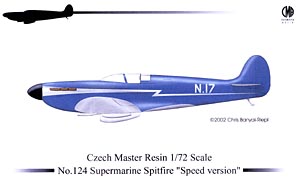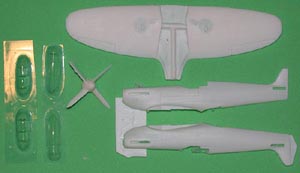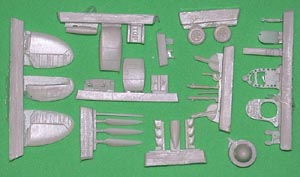Czech Master Resin 1/72 Supermarine Type 323 Speed Spitfire |  | History In late 1936 the prototype Spitfire flew 349 MPH at 16,800 feet and 290 MPH at 245 feet, the altitude required by the Federation Aeronautique International (FAI) for "official" speeds. Supermarine's thoughts immediately turned to modifying a Spitfire for an attempt on the world landplane speed record, which stood at 352 mph set by Howard Hughes in 1935 in his H-1, powered by an 825 hp Pratt & Whitney R-1535, 14 cylinder twin-row radial engine. Rolls-Royce set to work to develop a "sprint" version of their V-12 Merlin II. In mid 1937, running on "hot" fuel brewed by Rod Banks of Schneider Trophy fame, they were showing 1,536 hp on the test bench. On the strength of this demonstration of horsepower, the Air Ministry contracted for two airplanes to be built for the record attempt (the second was later cancelled). In early November of 1937 RR committed to have 1,995 hp available, which it was calculated would be sufficient for 375 mph in a suitably modified Spitfire. In late November 1937 the Messerschmitt Bf-109 V13 officially flew 379.38 mph. By May of 1938 RR were demonstrating 2,122 hp, which should have permitted the Speed Spitfire to exceed the German mark by the one percent required by the FAI to set a record. But the Germans raised the bar to 394.42 mph in June with the Heinkel He.100 V2. The Supermarine Type 323 Speed Spitfire, K9834, first flew November 11, 1938. In February it demonstrated 489 mph at 3,000 feet, which was calculated to be 400 mph at the lower official FAI record altitude. 399 mph would be required to beat the Heinkel. Knowing the Germans weren't finished with their record setting attempts Supermarine turned to steam/condensation engine cooling in an effort to obtain a larger margin over the standing record. Steam cooling would permit deletion of the external coolant radiator, substantially reducing drag. These modifications, including fitment of a constant speed three blade propeller, were put in hand and testing resumed. Remember, that Supermarine's own S6B Schneider racer had set the, then, absolute world air speed record at 407.5 mph on September 29, 1931 using a Rolls-Royce R27 engine of 2,600 hp. The "R" (Race) engines were the direct predecessors of the Merlin series of production engines. The Germans finshed it all in 1939. On March 30 the Heinkel He.100 V8 with 1,175 hp flew 463.97 mph finally wresting the absolute world air speed record from the Macchi-Castoldi M.C.72 Schneider floatplane racer. The M.C.72 had flown 442 mph in 1934 powered by the 3,100 hp Fiat AS.6, V-24 engine. On April 26 Messerschmitt shelved the absolute speed record for more than 30 years when their Me.209 V1, with 1,550 hp, flew 469.22 mph. Both the Heinkel He.100's and the Me.209 were powered by special versions of the Daimler-Benz DB.601 steam cooled, inverted, V-12 engine. The Brits' efforts with the Spitfire, designed as a fighter, were doomed to failure from the start but poor military intelligence didn't let them know that. The He.100, also designed as a fighter, was about 30% smaller and its low pressure steam/condensation cooling system was elemental in its design; not an afterthought. The Me.209, smaller still, was purpose-designed to take the absolute world speed record; its high pressure steam/condensation cooling system made it useless as a fighter prototype as subsequent efforts proved. The Speed Spitfire is an attractive airplane. It was painted Royal Blue (your guess is as good as mine as to what color that actually is but I've chosen Floquil Santa Fe Blue for mine) with silver painted under surfaces, including the wheel wells. A silver speed stripe runs from the propeller spinner to the trailing edge of the rudder. The class-B registration "N.17" was also silver. The huge four blade fixed-pitch wooden propeller and its spinner were painted satin black. In early testing the plane had a silver painted prop and spinner with red blade tips. The black prop had no color at its blade tips. By the time the Speed Spit was ready for flight testing of the steam cooling system the war had pushed record setting to the bottom of the RAF's list of priorities and development of the record airplane was sluggish. Whilst taxying out for its first flight with the new cooling system in April 1940 the condensation tank split and the speed record project was abandoned. In an attempt to make K9834 useful to the RAF a stock Merlin XII engine was installed along with a standard propeller, radiator, oil cooler, and all normal Spitfire Mk.I systems and a skinny "whip" antenna in place of the customary mast. It was assigned to the Photographic Development Unit at Heston as the sole Spitfire PR.3. There it was fitted with a Fairchild F-24 camera for oblique photography from a camera port in the left side of the fuselage aft of the cockpit. At this stage K9834 still had its Blue/silver color scheme but now had standard large yellow outlined fuselage roundels, standard underwing roundels, a small fin flash and no overwing roundels. A simple out-and-back test mission from St. Eval to Calais was attempted, but due to the small fuel capacity of only 60 Imperial Gallons, a small diversion from the flight plan, avoiding a Ju.88, required the mission be aborted. K9834 was then transferred to the Photographic Reconnaissance Unit at RAF Benson where it became the station hack. At this time it was fitted with a standard late Mk.I windscreen and bulged hood. In this last configuration the plane was painted overall PRU Blue with normal roundels in six places and fin flash for the period. The speed stripe on the fuselage was now painted red. The instruction sheet skeptically mentions this last color scheme but I am convinced of its validity from examining the gray scales in a pair of photos in the references. K9834 was scrapped June 14, 1946. The Kit  This kit looks good upon removal from its resealable plastic bag. 38 sharp, crisp, bubble free resin parts, four vac-formed clear parts, a small decal sheet and four sides of extremely well illustrated instructions comprise the whole thing. in the HISTORY given above, three color schemes and three physical configurations are described. The kit's instructions address all three physical configurations but only the first two color schemes. The parts provided will permit you to build any of the three physical configurations but you'll have to raid your stock of decals to do the overall PRU Blue with red speed stripe final livery. This kit looks good upon removal from its resealable plastic bag. 38 sharp, crisp, bubble free resin parts, four vac-formed clear parts, a small decal sheet and four sides of extremely well illustrated instructions comprise the whole thing. in the HISTORY given above, three color schemes and three physical configurations are described. The kit's instructions address all three physical configurations but only the first two color schemes. The parts provided will permit you to build any of the three physical configurations but you'll have to raid your stock of decals to do the overall PRU Blue with red speed stripe final livery.
In early 1995 I became intrigued by the Speed Spitfire and wrote and illustrated an article about it for our IPMS-Seattle monthly newsletter, which article later appeared in the IPMS/USA Journal. Using the research required to do the article I started a 1:72 scale model. It was a "scratch-kit-bash-conversion" based upon an Airfix Mk.I, a Hasegawa Mk.I, an Aeroclub Speed Spitfire conversion kit, a Cooper Details resin interior and an Eduard photo-etched brass interior. As only the propeller (and it only after much modification) and the vac-formed windscreen from the Aeroclub kit were usable, I made my own radiator, oil cooler and tailskid. This project was well along when it was set aside.  CMR's intentions to kit this subject brought it back to life for me. I loaned my drawings to our publisher, Chris Banyai-Riepl, as a basis for his color profile to be used in CMR's packaging. Unfortunately, between the time that Chris sent me his first draft of the profile and the time I e-mailed my critique of it back to him, CMR were ready to go to print and used the uncorrected first draft of the rendering, which is not quite 100% accurate but still looks great. I've an 8" x 10" print of the rendering on my wall. CMR's intentions to kit this subject brought it back to life for me. I loaned my drawings to our publisher, Chris Banyai-Riepl, as a basis for his color profile to be used in CMR's packaging. Unfortunately, between the time that Chris sent me his first draft of the profile and the time I e-mailed my critique of it back to him, CMR were ready to go to print and used the uncorrected first draft of the rendering, which is not quite 100% accurate but still looks great. I've an 8" x 10" print of the rendering on my wall.
With this kit in hand I plan to kit bash some of my seven year old (No, not Scotch) parts into the CMR kit for my model of the Speed Spit. This is a great kit; it's better than any other complete resin 1:72 scale kit I've seen. If you use the kit's interior, which is made up of six separate pieces and lots of cockpit sidewall detail molded in place, you'll have a better interior than most injection molded kits on the market today. My subjective quibbles with the kit are: · Tailskid: Upper shape not quite right. · Undercarriage covers: Too thick. · Undercarriage legs: Detail is accurate, but a bit soft. · Overwing wheel well bulges: Too large and too far inboard. · Rudder push-pull rod: Missing from left side of fuselage. · Propellers: No twist from the coarse root pitch to the finer tip pitch. · Control surfaces: The dreaded "Fabric Texture" is back and the outboard ends of the aierons are not quite right. · Instruction sheet: 1. Does not indicate need to delete right hand inboard flap and reduce span of outboard flap to clear the larger radiator. 2. Does not show the third PRU Blue color scheme. 3. No indication of where the camera port was on the second configuration of the airplane. Decal sheet:  1. Insignia blue color is essentially black. 1. Insignia blue color is essentially black.
2. Markings for the third- PRU Blue - color scheme are missing. Conclusion If you like beautiful airplanes buy and build this kit. I understand that the CMR line of kits is available from Squadron Mail Order in North America. References AIR INTERNATIONAL Magazine, February 1978 & September 1990. SPITFIRE - THE HISTORY: E.B. Morgan & E. Shacklady, Key Publishing, Stamford, Lincs. 1987, ISBN 0-946219-109. THE SPITFIRE STORY: A. Price, Jane's, London, 1982, ISBN 0-86720-6241. SCALE MODELS INTERNATIONAL MAGAZINE: October 1984 & January 1985. AEROPLANE MONTHLY Magazine: May 1983 & August 1990. BENT THROTTLES - Journal of the Racing and record Aicraft Special Interest Group of IPMS-UK; No. 3, June 1997 & No. 12, September 1999. | 







|

 This kit looks good upon removal from its resealable plastic bag. 38 sharp, crisp, bubble free resin parts, four vac-formed clear parts, a small decal sheet and four sides of extremely well illustrated instructions comprise the whole thing. in the HISTORY given above, three color schemes and three physical configurations are described. The kit's instructions address all three physical configurations but only the first two color schemes. The parts provided will permit you to build any of the three physical configurations but you'll have to raid your stock of decals to do the overall PRU Blue with red speed stripe final livery.
This kit looks good upon removal from its resealable plastic bag. 38 sharp, crisp, bubble free resin parts, four vac-formed clear parts, a small decal sheet and four sides of extremely well illustrated instructions comprise the whole thing. in the HISTORY given above, three color schemes and three physical configurations are described. The kit's instructions address all three physical configurations but only the first two color schemes. The parts provided will permit you to build any of the three physical configurations but you'll have to raid your stock of decals to do the overall PRU Blue with red speed stripe final livery. CMR's intentions to kit this subject brought it back to life for me. I loaned my drawings to our publisher, Chris Banyai-Riepl, as a basis for his color profile to be used in CMR's packaging. Unfortunately, between the time that Chris sent me his first draft of the profile and the time I e-mailed my critique of it back to him, CMR were ready to go to print and used the uncorrected first draft of the rendering, which is not quite 100% accurate but still looks great. I've an 8" x 10" print of the rendering on my wall.
CMR's intentions to kit this subject brought it back to life for me. I loaned my drawings to our publisher, Chris Banyai-Riepl, as a basis for his color profile to be used in CMR's packaging. Unfortunately, between the time that Chris sent me his first draft of the profile and the time I e-mailed my critique of it back to him, CMR were ready to go to print and used the uncorrected first draft of the rendering, which is not quite 100% accurate but still looks great. I've an 8" x 10" print of the rendering on my wall. 1. Insignia blue color is essentially black.
1. Insignia blue color is essentially black.






